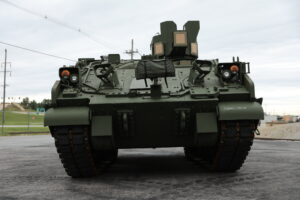HUNTSVILLE, Ala. — BAE Systems is moving portions of its production work to other facilities to ensure its York, Pennsylvania manufacturing site has expanded capacity to build the Army’s Armored Multi-Purpose Vehicle (AMPV) and Marine Corps’ Amphibious Combat Vehicles, according to a company official.
Jim Miller, BAE Systems’ vice president of business development for combat mission systems, said the company has invested $250 million to support production increase efforts and has received another $27 million through the Ukraine supplemental funding measures for facility improvements at York for ramping up manufacturing of AMPVs, which are replacing the legacy M113s armored personnel carriers provided to Kyiv.

“We want to be able to move fast. The Army wants to move fast and increase the capacity for delivering AMPV. We also have a major customer called the United States Marine Corps and we’ve got to take care of them on the ACV at the same time. So as we look at our industrial network, we’ve got to be able to flex and grow that and be pretty agile about that, given the demands we see in front of us,” Miller told reporters on Wednesday during a briefing at the Association of the United States Army’s Global Force Symposium here.
The push to create more room at the York facility arrives the Army nears a full-rate production decision on AMPV, with the service previously citing a goal to increase production from 12 to around 16 vehicles per month, and as BAE Systems continues building ACVs for the Marine Corps.
“We want to create more room for AMPV there and we’ve clearly got to sustain what we’re doing on ACV there as well. In order to do that, we need to move some things,” Miller said.
For BAE Systems’ M88 recovery vehicles, Miller said the company is planning to have a partner take over the hulls that will then be delivered to the company’s facility in Anniston, Alabama for assembly.
“We’re going to take some of that hull work that we do for M88 and we’re going to move that to a partner. And we’ll let you know as soon as we can announce who that is,” Miller said.
Fabrication of hulls for the Army’s Self-Propelled Howitzer Paladin Integrated Management (PIM) will still be done at York, but Miller said assembly of the M109A7 self-propelled howitzer and ammunition vehicle for that program will be moved to Anniston. Final assembly and testing for PIM will still take place at the BAE Systems’ facility in Elgin, Oklahoma.
“That’s going to free up a lot of space for us at York. The Army would like us to be able to produce over 190 AMPVs a year and we’re going to go to that very quickly at York with this move,” Miller told reporters.
When asked if the build timeline for programs like PIM would be affected by location changes, Miller said, “we don’t think so.”
“Our estimate is it’s not [going to]. We’re going to be able to stay on contract, stay on our deliveries,” Miller responded.
Miller said no final decision has been made yet if the York facility will need further expansion to meet AMPV and ACV production requirements, adding that “if we get additional demands, maybe.”
As the Army hit its first unit equipped milestone for AMPV earlier this month, officials told reporters the service’s new goal of working toward annually delivering “a brigade and a half” worth of the vehicles within two years was “driven by the need to get more vehicles faster to replace what we’re providing to Ukraine” (Defense Daily, March 14).
“We’ve benefited from pretty generous supplemental funding from Congress. And so, we’ve shipped several hundred M113s over to Ukraine to support that effort there. And the intent is to backfill that inventory with new vehicles, with AMPVs,” Jim Schirmer, the Army’s deputy program executive officer for ground combat systems, told reporters. “Because of the additional supplemental funding to backfill the M113s that we’re drawing down from the inventory, the new goal is a brigade-and-a-half. And [that] is what we believe is the capacity at the [BAE Systems] plant in York, [Pennsylvania].
BAE Systems noted its investment into the York facility includes installing additional paint booths, bolstering robotic welding capabilities and increasing laser cutting capabilities.
“We replaced every machine at our machining center at York. And these are not small machines. These are big, giant, wouldn’t fit in your garage [type of] machines,” Miller said on Wednesday.